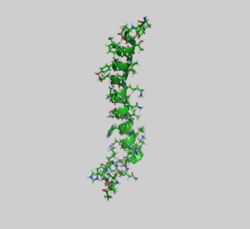Gastric inhibitory polypeptide
Gastric inhibitory polypeptide (GIP), or gastric inhibitory peptide, also known as glucose-dependent insulinotropic polypeptide (also abbreviated as GIP), is an inhibiting hormone of the secretin family of hormones.[5] While it is weak inhibitor of gastric acid secretion, its main role is to stimulate insulin secretion.[6]
GIP, along with glucagon-like peptide-1 (GLP-1), belongs to a class of molecules referred to as incretins.[7]
Synthesis and transport
GIP is derived from a 153-amino acid proprotein encoded by the GIP gene and circulates as a biologically active 42-amino acid peptide. It is synthesized by K cells, which are found in the mucosa of the duodenum and the jejunum of the gastrointestinal tract.[8]
Like all endocrine hormones, it is transported by blood.
Gastric inhibitory polypeptide receptors are seven-transmembrane proteins found on beta-cells in the pancreas.
Functions
It has traditionally been named gastrointestinal inhibitory peptide or gastric inhibitory peptide and was found to decrease the secretion of stomach acid[9] to protect the small intestine from acid damage, reduce the rate at which food is transferred through the stomach, and inhibit the GI motility and secretion of acid. However, this is incorrect, as it was discovered that these effects are achieved only with higher-than-normal physiological level, and that these results naturally occur in the body through a similar hormone, secretin.[10]
It is now believed that the function of GIP is to induce insulin secretion, which is stimulated primarily by hyperosmolarity of glucose in the duodenum.[11] After this discovery, some researchers prefer the new name of glucose-dependent insulinotropic peptide, while retaining the acronym "GIP." The amount of insulin secreted is greater when glucose is administered orally than intravenously.[12]
In addition to its role as an incretin GIP is known to inhibit apoptosis of the pancreatic beta cells and to promote their proliferation. It also stimulates glucagon secretion and fat accumulation. GIP receptors are expressed in many organs and tissues including the central nervous system enabling GIP to influence hippocampal memory formation and regulation of appetite and satiety.[13]
GIP recently appeared as a major player in bone remodeling. Researchers at Universities of Angers and Ulster evidenced that genetic ablation of the GIP receptor in mice resulted in profound alterations of bone microarchitecture through modification of the adipokine network.[14] Furthermore, the deficiency in GIP receptors has also been associated in mice with a dramatic decrease in bone quality and a subsequent increase in fracture risk.[15] However, the results obtained by these groups are far from conclusive because their animal models give discordant answers and these works should be analysed very carefully.
Pathology
It has been found that type 2 diabetics are not responsive to GIP and have lower levels of GIP secretion after a meal when compared to non-diabetics.[16] In research involving knockout mice, it was found that absence of the GIP receptors correlates with resistance to obesity.[17]
References
- GRCh38: Ensembl release 89: ENSG00000159224 - Ensembl, May 2017
- GRCm38: Ensembl release 89: ENSMUSG00000014351 - Ensembl, May 2017
- "Human PubMed Reference:". National Center for Biotechnology Information, U.S. National Library of Medicine.
- "Mouse PubMed Reference:". National Center for Biotechnology Information, U.S. National Library of Medicine.
- Meier JJ, Nauck MA (2005). "Glucagon-like peptide 1(GLP-1) in biology and pathology". Diabetes/Metabolism Research and Reviews. 21 (2): 91–117. doi:10.1002/dmrr.538. PMID 15759282.
- Pederson RA, McIntosh CH (2016). "Discovery of gastric inhibitory polypeptide and its subsequent fate: Personal reflections". Journal of Diabetes Investigation. 7 Suppl 1: 4–7. doi:10.1111/jdi.12480. PMC 4854497. PMID 27186348.
- Efendic S, Portwood N (2004). "Overview of incretin hormones". Hormone and Metabolic Research. 36 (11–12): 742–6. doi:10.1055/s-2004-826157. PMID 15655702.
- Costanzo, Linda (2014). Physiology. Philadelphia, PA: Saunders/Elsevier. p. 337. ISBN 9781455708475.
- Kim W, Egan JM (Dec 2008). "The role of incretins in glucose homeostasis and diabetes treatment". Pharmacological Reviews. 60 (4): 470–512. doi:10.1124/pr.108.000604. PMC 2696340. PMID 19074620.
- Creutzfeldt, Werner; Ebert, Reinhold; Ørskov, Cathrine; Bartels, Eckart; Nauck, Michael A. (1992). "Lack of Effect of Synthetic Human Gastric Inhibitory Polypeptide and Glucagon-LikePeptide 1 [7-36 Amide] Infused at Near-Physiological Concentrations on Pentagastrin-Stimulated Gastric Acid Secretion in Normal Human Subjects". Digestion. 52 (3–4): 214–221. doi:10.1159/000200956. ISSN 0012-2823. PMID 1459356.
- Thorens B (Dec 1995). "Glucagon-like peptide-1 and control of insulin secretion". Diabète & Métabolisme. 21 (5): 311–8. PMID 8586147.
- Boron WF, Boulpaep EL (2009). Medical physiology: a cellular and molecular approach (2nd International ed.). Philadelphia, PA: Saunders/Elsevier. ISBN 9781416031154.
- Seino, Yutaka; Fukushima, Mitsuo; Yabe, Daisuke (2010). "GIP and GLP-1, the two incretin hormones: Similarities and differences". Journal of Diabetes Investigation. 1 (1–2): 8–23. doi:10.1111/j.2040-1124.2010.00022.x. PMC 4020673. PMID 24843404.
- Gaudin-Audrain C, Irwin N, Mansur S, Flatt PR, Thorens B, Baslé M, Chappard D, Mabilleau G (Mar 2013). "Glucose-dependent insulinotropic polypeptide receptor deficiency leads to modifications of trabecular bone volume and quality in mice" (PDF). Bone. 53 (1): 221–30. doi:10.1016/j.bone.2012.11.039. PMID 23220186.
- Mieczkowska A, Irwin N, Flatt PR, Chappard D, Mabilleau G (Oct 2013). "Glucose-dependent insulinotropic polypeptide (GIP) receptor deletion leads to reduced bone strength and quality". Bone. 56 (2): 337–42. doi:10.1016/j.bone.2013.07.003. PMID 23851294.
- Skrha J, Hilgertová J, Jarolímková M, Kunešová M, Hill M (2010). "Meal test for glucose-dependent insulinotropic peptide (GIP) in obese and type 2 diabetic patients". Physiological Research. 59 (5): 749–55. PMID 20406045.
- Yamada Y, Seino Y (2004). "Physiology of GIP--a lesson from GIP receptor knockout mice". Hormone and Metabolic Research. 36 (11–12): 771–4. doi:10.1055/s-2004-826162. PMID 15655707.
External links
- Gastric+inhibitory+polypeptide at the US National Library of Medicine Medical Subject Headings (MeSH)
- King MW (16 November 2006). "Gastrointestinal Hormones and Peptides". Indiana University – Purdue University Indianapolis School of Medicine. Archived from the original on 6 December 2007. Retrieved 1 October 2006.
- Overview of all the structural information available in the PDB for UniProt: P09681 (Gastric inhibitory polypeptide) at the PDBe-KB.




